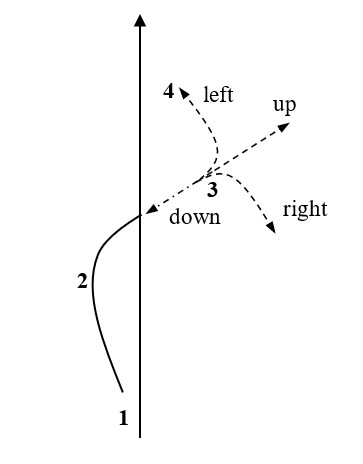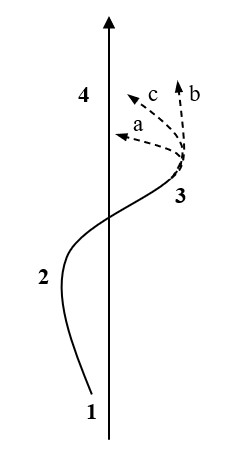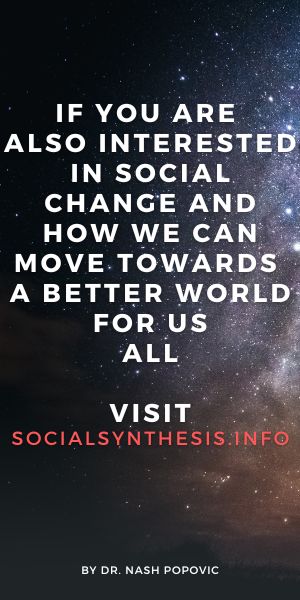SOCIAL DEVELOPMENT
Trajectory

Written by Nash Popovic
In dialectical terms, social development can be described first as the move away from the general direction of the Intent and then back towards it. The thesis (an unconscious alignment) would correspond to the physical stage; the antithesis (separation – the process of individuation and increasing independence) includes the move from the physical stage and, via the conventional stage, reaches its peak at the individual stage; the synthesis (a conscious re-alignment with the direction of the Intent) is represented by the transcendent stage.
This is a very simple diagram of the process:

The curve should be imagined as a spiral around the central axis (the length of its segments do not correspond to physical time, but to an approximate amount of change that took place). Moreover, the spiral is not a simple line. A smaller spiral going around it, as drawn between the physical and the conventional stages (and other spirals around that one) would be a better representation. But, why spirals at all? Is there any justification for that?
In the introduction to History & Mathematics, Trends and Cycles, Leonid Grinin and Andrey Korotayev write:
Already ancient historians… described rather well the cyclical component of historical dynamics, whereas new interesting analyses of such dynamics also appeared in the Medieval and Early Modern periods… This is not surprising as the cyclical dynamics was dominant in the agrarian social systems. With modernization, the trend dynamics became much more pronounced… The trend and cycle components of historical dynamics turn out to be of equal importance.
 The long-term interaction of macrotrends of the world system development and shorter-term cyclical dynamics is best represented by a spiral dynamic. This is not something new. The curve reflects a well-known symbol from ancient times, depicted with two intertwined serpents around God’s staff, called the caduceus (still used nowadays as a medical emblem). It is, perhaps, not a coincidence that this symbol resembles the double helix of DNA. In esoteric tradition, the two serpents of the caduceus represent the process of evolution[1]: ‘spirit descending into matter and rising again enlightened into spirit’ (Watson, 1991, p.307). The serpent has traditionally symbolised knowledge, enlightenment and wisdom (the Western association with evil is relatively recent and atypical). From this perspective, the myth of the serpent inviting Adam and Eve to eat of the tree of knowledge can be interpreted as the start of a new phase of the evolutionary process, ‘a liberation from unconscious limitations and the dawn of self-consciousness’ (ibid).
The long-term interaction of macrotrends of the world system development and shorter-term cyclical dynamics is best represented by a spiral dynamic. This is not something new. The curve reflects a well-known symbol from ancient times, depicted with two intertwined serpents around God’s staff, called the caduceus (still used nowadays as a medical emblem). It is, perhaps, not a coincidence that this symbol resembles the double helix of DNA. In esoteric tradition, the two serpents of the caduceus represent the process of evolution[1]: ‘spirit descending into matter and rising again enlightened into spirit’ (Watson, 1991, p.307). The serpent has traditionally symbolised knowledge, enlightenment and wisdom (the Western association with evil is relatively recent and atypical). From this perspective, the myth of the serpent inviting Adam and Eve to eat of the tree of knowledge can be interpreted as the start of a new phase of the evolutionary process, ‘a liberation from unconscious limitations and the dawn of self-consciousness’ (ibid).
For the sake of simplification, the social development diagram has only one curve, while the caduceus has two (one black and one white) that are intertwined. This is more accurate. So, what does that other spiral (or snake) represent? We suggest that it represents harmonising social processes. As with individuals, societies too need to be integrated to some extent in order to survive and develop. There are many factors that contribute to social (dis)harmony. Peter Turchin, who specialises in cultural evolution and the dynamics of historical societies, picked up arguably one of the most significant and easily recognisable factors – inequality (following Kevin Philips’ measure of inequality). Having been studying societies from the days of Rome to the recent American history, he and his colleagues argue that societies move in cycles between wealth (and, we would add, power) concentration and wealth (and power) distribution:
Over periods of two to three centuries, we found repeated back-and-forth swings in demographic, economic, social, and political structures. And the cycles of inequality were an integral part of the overall motion.
We can easily imagine that this applies not only to individual societies but to relative harmony among societies in particular regions, and even globally. Of course, this is a very complex process. Turchin continues:
Incidentally, when students of dynamical systems… talk about ‘cycles’, we do not mean rigid, mechanical, clock-like movements. Cycles in the real world are chaotic, because complex systems such as human societies have many parts that are constantly moving and influencing each other. Despite this complexity, our historical research on Rome, England, France, Russia and now the US shows that these complex interactions add up to a general rhythm. Upward trends in variables (for example, economic inequality) alternate with downward trends.
In the face of many challenges, social harmonising often take priority over social development, so we find here again a kind of punctuated equilibrium:
It is obvious that the qualitative innovative motion toward new, unknown forms, levels, and volumes, etc. cannot continue endlessly, linearly and smoothly. It always has limitations, accompanied by the emergence of imbalances, increasing resistance to environmental constraints, competition for resources, etc. …relatively short periods of rapid growth (which could be expressed as a linear, exponential or hyperbolic trend) tended to be followed by stagnation, different types of crises and setbacks, which created complex patterns of historical dynamics, within which trend and cyclical components were usually interwoven in rather intricate ways. (Grinin and Korotayev, 2014, p.5)
The shape of the spirals and their pace are largely the result of the choices that societies have made throughout their history, and of the capacity to build on previous learning and development. However, particularly the pace has to be within certain limits. If the process is too slow, the society can diminish (or be taken over). Too fast a move leads to instability. This is balanced by the usually alternating conservative and progressive forces in a society. For example, in parliamentary systems, these forces are represented by opposing political parties that usually take turns in governance. These define the shape of local spirals, but occasionally we get to a point at which it is possible to change the direction (‘bend’ the curve) of more global trends. These are the moments of supreme responsibility, everything else is inertia. Such events usually (although not always) take place in times of outside pressures or/and internal pressures, and the ensuing change may or may not be progressive. We are now at one such point – arguably, the most important one.
Turchin (and some other scholars who study dynamic systems) somewhat optimistically believes that discerning the historical pattern of cycles through mathematical modelling can be used to predict the future. From a spiral (rather than a cyclical) perspective this is far less certain, as the cycles do not simply repeat themselves – every cycle is different from the previous one as it brings more chaotic dynamics and therefore more unpredictability. This is similar to another chaotic system – the weather. Although we can recognise the weather cycles, we are still not very good at predicting what will happen three days from now (particularly because of the human influence on the climate). What we can do, though, is examine the most likely possibilities.
[1] Caduceus has a greater number of bends because it presumably personifies the whole of evolution, while the above diagram refers only to social development.
The Futures
One of the purposes of the above brief historical account is to show that human agency increases throughout this process and consequently its influence on social development. In the past, biological and social determinants have played a much greater role, so the social dynamic was much more conditioned. However, this trend has been steadily decreasing, to be overtaken by greater choice (not so long ago, only few, if any, could exercise their choice in important matters, while nowadays this is taken for granted by the large majority). Granted, ego determinism (‘programming’ ourselves) may be on the rise, but overall determinism is lower than ever. For the first time we can consciously and intentionally shape the direction of our destiny. This is also a great responsibility, as the future is really in our hands. We actually reached this point some time ago, but the final move after which inertia takes over has not yet been made. We are still at a crossroads, which means that the future is truly unpredictable. Four possible general directions can be postulated, as shown in the following diagramme[2]:

Down: a return to anachronistic social structures, run by an ideological or religious oligarchy. It would be a step backwards that would postpone the real choice for some time, but not indefinitely [3].
Right: moving away from the Intent, which would end in a technocratic / corporate autocracy (a nightmarish world, often depicted in dark futuristic stories and films). This option is likely to eventually lead to destruction, possibly by triggering an environmental disaster or a catastrophic war. In this case, the suffering and efforts of countless lives that have contributed to our evolution and social development would be in vain. This would be a tragedy of unimaginable proportions, but it is not impossible.
Up: continuing in the same direction would lead to meaningless, apathetic reality, in which entropy would be constantly increasing, ending eventually in a kind of anarchy and social fragmentation. This one is unlikely to destroy the world completely, simply because the means of destruction would malfunction too. However, it would result in a slow decline. To reverse this trend, a new conceptual framework (a new start) would be required.
Left: recognising and aligning the collective intentions and actions with the universal. In other words, discovering or creating a common purpose, which would contribute not only to social development but to harmonisation too.
It is impossible to predict which of them will prevail. What is certain is that they are all already germinated:
- The rise of nationalism and religious fundamentalism in, for example, some parts of the Middle East and the USA indicates the down direction.
- Extreme materialism that started a few decades ago in the West, but is now taking roots in newly developed countries, points towards the right.
- Secularism that has grown out of post-modernist ideas (in the liberal parts of the USA, most of Europe, and some other, predominantly Western countries) leans towards the up direction.
- Some secular and spiritual movements show signs of a shift towards the ‘left’. These are just a few examples: an increasing number of individuals and organisations dedicated to raising awareness and tackling global issues; the growth of the so-called third sector (social enterprises, co-ops, charities) driven by contribution to community rather than profit; certain technical advances such as the internet that provide largely free and decentralised information and a vast knowledge base (although not always used to good ends); the emergence and fast spreading of grass-root spirituality, not aligned to any specific religious doctrine – this is becoming a dominant trend, at least in the West[4], and includes diverse approaches, some of which are theistic and some atheistic (based on the idea of self-generating systems). This direction may not prevail, but it is the most interesting one, so we will consider some possibilities within it.
The left turn trajectories can be grouped into three broad categories (this is actually a spectrum – the lines are used only for convenience):
a) Taking a too sharp turn towards the Intent, which is likely to happen if development is prioritised over harmonisation. This might involve a kind of revolutionary, top-down process, that could become dogmatic. The consequence of such a sharp turn could be approaching the flow of the Intent from a somewhat wrong angle, like a boat that tries to enter a river perpendicular to its flow, which runs the risk of being thrown back.
b) Taking a too wide turn towards the Intent positions this move between the left and the up trajectories. It can happen if harmonisation takes priority over development, and it is likely to be a generic, secular, bottom up shift. It could make life better, but it may approach the flow of the Intent very slowly or even move in parallel with it. The meaning would remain more or less elusive, and the search could continue indefinitely.
c) Approaching the flow of the Intent from a right-angle (somewhere in between the above two) and gradually aligning with it. This would require combining a revolutionary process and generic processes into an evolutionary process. It would need to balance development and harmonisation, and would involve the synthesis of theory and practice, top down and bottom up, global and local.[5] The question may be asked: what would happen if this is achieved? A bridge will be created, and humanity will not be alone any more.
[2] Their names are derived from the image and do not have ideological connotations.
[3] To get rid destructive consumerism, some find attractive returning even further, to the state of humankind childhood. But children are easily mesmerised with multi-coloured superstores and junk-food outlets. Nor are adults from pre-industrial societies immune to flashy but pointless products. We won’t find answers to the ills of modern society there. We will just have to claim the same mountain again.
[4] For further details, see Forman, 2004
[5] For an alternative political and economic model based on these principles, and suggestions how to make the change, see Social Synthesis.


